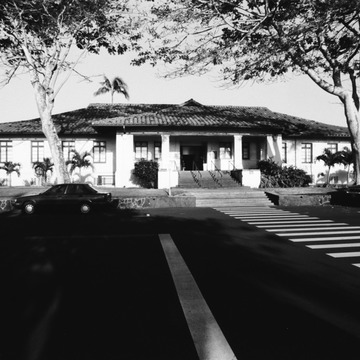Graceful and well proportioned, the Circuit Court is a fine example of a late 1930s Hawaiian adaptation of Spanish Mission style. Sitting on a raised foundation, the symmetrical, single-story, reinforced-concrete building includes the style's hallmarks: stuccoed walls and a red tile roof. But the roof is low pitched and of Hawaiian style, double-pitched and hipped with gablets. In addition, the building features a projecting centered entrance lanai with square columns. Kapa-like concrete blocks incised in a herringbone pattern provide decoration and ventilation for the basement. The circuit court has a cruciform floor plan, and the lanai leads into an octagonal-shaped foyer featuring a coffered ceiling with articulated, low-arched openings that provide access to the other three wings. Originally this building was intended for the park fronting the Kauai County Building; however, as a result of public outcry to maintain the open space, Umi Street was developed and the courthouse relocated to face the new street.
You are here
Circuit Court Building
If SAH Archipedia has been useful to you, please consider supporting it.
SAH Archipedia tells the story of the United States through its buildings, landscapes, and cities. This freely available resource empowers the public with authoritative knowledge that deepens their understanding and appreciation of the built environment. But the Society of Architectural Historians, which created SAH Archipedia with University of Virginia Press, needs your support to maintain the high-caliber research, writing, photography, cartography, editing, design, and programming that make SAH Archipedia a trusted online resource available to all who value the history of place, heritage tourism, and learning.


